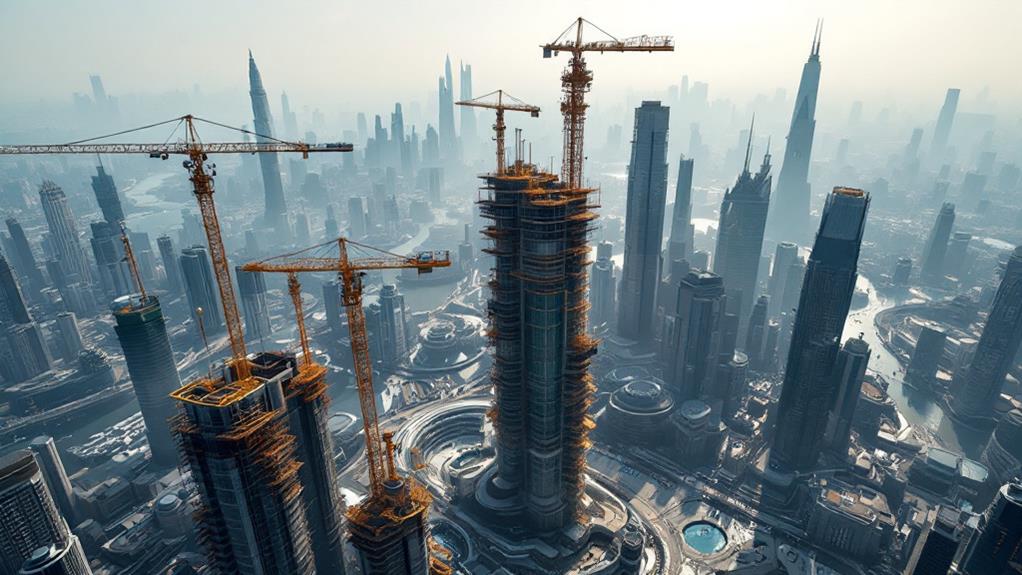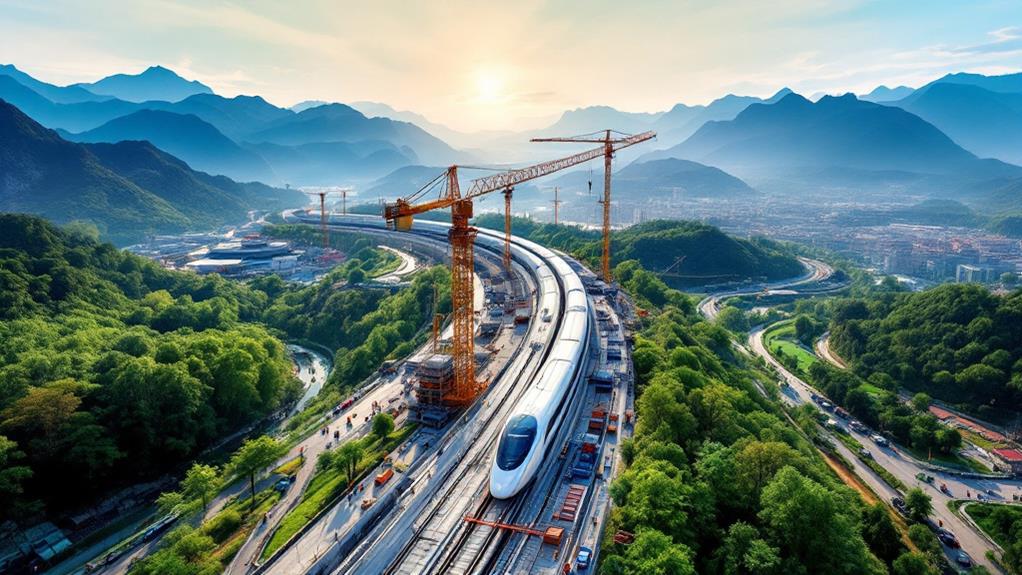Top 5 Largest Ongoing Building Projects in China

You're about to uncover China's top five largest ongoing building projects. To begin, the Belt and Road Initiative connects billions through extensive trade routes, with a staggering $1.3 trillion investment. The South North Water Transfer tackles water scarcity, transporting immense volumes across the country. The Chongqing Kunming High-Speed Rail revolutionizes travel with reduced transit times between major cities. Hainan Tourism Development aims to transform the island into a global destination with a $50 billion investment. Finally, the Chengdu Metro Expansion improves urban mobility with its extensive network and AI integration. There's much more to reveal about these transformative efforts.
Belt and Road Initiative
Imagine a project so vast that it seeks to connect nearly half the world's population. Welcome to the Belt and Road Initiative, the world's largest infrastructure endeavor, launched by President Xi Jinping in 2013. This monumental plan aims to revive the ancient Silk Road by enhancing global connectivity through massive investments across Asia and Europe. With an estimated $1.3 trillion investment by 2027, the initiative will link about 3 billion people, creating the largest market globally.
By incorporating both land and maritime routes, the Belt and Road Initiative facilitates trade, cultural exchange, and economic development among participating countries. You'll find key projects like railways, highways, ports, and energy pipelines that markedly enhance transportation and logistics capabilities. These projects don't just stand as feats of engineering; they aim to transform economies and foster sustainable growth in the regions involved.
As you investigate this initiative, notice how it strengthens regional cooperation across diverse sectors. The impacts are profound, promising a future where economies of participating nations experience a new chapter of development and collaboration. This initiative isn't just about building; it's about connecting the world on an unprecedented scale.
South North Water Transfer
The South North Water Transfer Project stands as one of China's most ambitious responses to its water scarcity crisis in the north. Officially launched in 2003, this monumental initiative aims to quench the thirst of northern China through a carefully planned effort extending over several decades. With a staggering budget exceeding $79 billion, the project has captured the attention of many, including diverse Investment Groups enthusiastic to participate in this colossal endeavor.
The project features three primary routes: eastern, central, and western. By 2050, these routes are expected to transport a whopping 44.8 billion cubic meters of water annually. The eastern route channels water from the Yangtze River to key cities like Beijing and Tianjin. Meanwhile, the central route directs water from the Danjiangkou Reservoir to northern regions. The western route focuses on bringing much-needed water to the arid areas of Xinjiang.
This massive infrastructure project, conceptualized in 1952, is set to impact over 500 million people by connecting major rivers across the country. It's a vital effort to sustain agricultural production and improve living standards in northern China, where water scarcity has long been a pressing issue.
Chongqing Kunming High-Speed Rail

Amidst China's robust commitment to modern transportation infrastructure, you'll find the Chongqing Kunming High-Speed Rail Project, spanning approximately 1,600 kilometers and designed for speeds up to 350 km/h. This ambitious project cuts through the challenging mountainous terrain, promising to drastically reduce travel times and improve connectivity between major urban centers. Imagine reducing the trip from Chongqing to Beijing from a lengthy 20 hours to just 7 hours—an incredible leap forward in efficiency.
This rail line is more than just a marvel of engineering; it's a catalyst for economic growth. By linking remote areas to thriving cities, it facilitates the movement of people and goods, promoting regional development and integration within China. The project forms a crucial part of China's extensive high-speed rail network, further cementing the nation's leadership in modern infrastructure.
While you might think of the Yellow River as a symbol of China's historical richness, projects like the Chongqing Kunming High-Speed Rail are a reflection of its future-forward vision. This substantial investment underscores China's dedication to fostering economic prosperity and improving accessibility across its vast landscape.
Hainan Tourism Development
Following the momentum of China's groundbreaking infrastructure endeavors, let's investigate the Hainan Tourism Development project. This ambitious initiative, spearheaded by the Hainan provincial government and backed by an impressive $50 billion investment, seeks to transform the island into a global tourism hub. Collaborating with international hotel chains and theme park operators, the project aims to enhance Hainan's allure, drawing in more international visitors. In 2019, over 70 million tourists visited Hainan, but the goal is to hit 100 million by 2025.
Already, this development is making waves in tourism numbers, even before its full completion slated for 2025. A key component is the expansion of Haikou Maan International Airport, essential for accommodating the influx of tourists and enhancing connectivity. This isn't just about numbers, though. The project promises to create jobs, invigorate local economies, and improve visitor experiences by enhancing facilities and attractions.
However, with any large-scale project, human error can pose challenges. Ensuring that the complex logistics, international partnerships, and vast construction efforts align smoothly is critical to avoiding setbacks. If successful, this project could set a new benchmark for tourism development worldwide.
Chengdu Metro Expansion

In 2022, Chengdu revealed its ambitious metro expansion, featuring 12 lines that span an impressive 58.96 kilometers. This development makes Chengdu Metro the fourth largest subway system globally, boasting 373 operational stations and 46 transfer stations. Since construction began in 2005, the metro has aimed to improve urban mobility and reduce travel time across the city. By integrating artificial intelligence technology by 2025, the system will augment operational efficiency, making your commute smoother and faster.
The introduction of AI will transform the metro's operations, allowing for smarter scheduling, predictive maintenance, and efficient crowd management. This technology will greatly enhance connectivity between communities, stimulate economic growth, and address the challenges of increasing urbanization and population density. As a commuter, you'll benefit from a more reliable and enjoyable traveling experience.
Chengdu Metro's ongoing expansion plans include 10 new lines, underscoring the city's commitment to modern urban transportation infrastructure. The expansion not only promises to improve daily commutes for millions but also strengthens Chengdu's economic and social fabric. As the network grows, you'll find it easier than ever to navigate the lively city, connecting you seamlessly to everything Chengdu has to offer.



